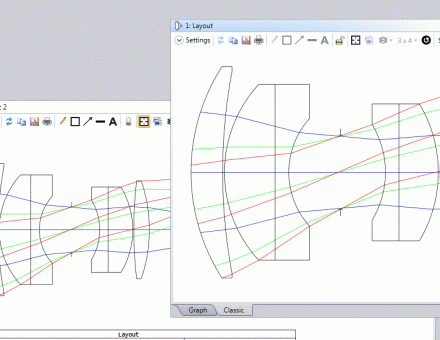“Scaling’ refers to a method where a known lens design is proportionally enlarged or reduced geometrically to meet a different image size requirement from what the lens was originally designed for. For example, say, we have a lens that was originally designed for a 1/3” format sensor with an image circle of 6mm, we can “scale” up that design to make the image circle 8mm. This new scaled-up design is now capable of supporting a 1/2″ format sensor with an image circle of 8mm.
All linear dimensions such as effective focal length, back focal length, total track length, or lens diameter scale linearly. Other properties such as field of view, F/#, distortion, and relative illumination do not change with scaling. Generally speaking, ratios or angular quantities are scaling invariant. Because the wavelength of interest does not scale, the diffraction MTF must be re-evaluated after scaling. It cannot be deduced from simple scaling.
For example, we have a new camera application requiring a lens that will provide 121 degree HFOV on a 1/2″ imager with an F/2.9 aperture. A standard 1/2″ imager has an effective width of 6.4mm. Our off-the-shelf DSL388 lens has an HFOV of 121 degrees HFOV on 6.2mm effective width. Using scaling we can “enlarge” the DSL388 by 6.4/6.2=1.03x or 3%. This new lens will provide 121 degree HFOV on the 1/2″ imager. The F/# of the new lens is still 2.9 unchanged. However, the total track length will now be 3% longer. To realize the new design in hardware all elements inside the lens must be re-made with 3% greater thickness, diameter, and radii values.
Attention must be paid when the scaling ratio is too large or small. The newly created design may present manufacturability difficulties or challenges. For example, if a lens is scaled down the center or edge thickness of some lens elements may become too thin to be manufacturable. If the lens is scaled up too much the weight or size of the lens elements could become too large or heavy to be economical. So before any prototype of the new design is made the optical design needs to be refined or adjusted to account for those issues.


